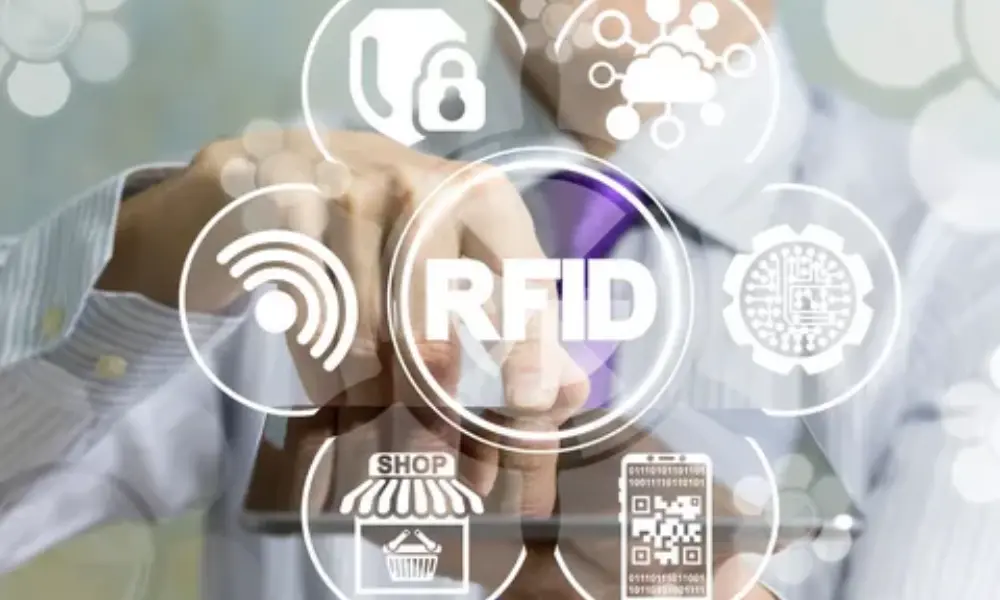
Fastag, toll scanners, and industrial goods have one thing in common – an RFID tag. Manual tracking is a thing of the past and there are several RFID tag uses in fast-moving industries like healthcare, logistics, and agriculture.
The tags are a crucial part of the RFID technology. They transmit information on critical assets through radio waves thereby helping businesses to streamline their supply chain operations.
Let’s go deep into the vital aspects of RFID tags and understand their benefits, types, and applications.
Understanding RFID Tags
Before we dive into the details of RFID tag uses, let’s first understand the RFID tag’s meaning. RFID tags are small, electronic devices that consist of a microchip and an antenna. They are capable of storing and transmitting information wirelessly to a reader or scanner using radio waves. The data on these tags can range from a simple serial number to more complex information like product details, patient records, or location data.
How do RFID tags work?
- Initialization: RFID tags are initially programmed with relevant information. This can include unique identification numbers, product descriptions, or other data.
- Interrogation: When an RFID reader emits radio waves, it activates the RFID tag. The tag’s antenna captures the energy from the radio waves and uses it to power the microchip.
- Data Transmission: The RFID tag’s microchip processes the information on the tag and transmits it back to the reader using radio waves. This data transmission is rapid and efficient, allowing for quick identification and tracking.
Now that we have a basic understanding of how the tags work, let’s explore the diverse range of RFID tag applications and benefits.
RFID Tag Uses in Various Industries
1. Retail
RFID tag uses in the retail industry are extensive and transformative. Retailers use RFID tags to manage inventory more efficiently, reducing stockouts and overstock situations. These tags enable precise tracking of products through the supply chain, from manufacturer to store shelves. This not only ensures products are always available when customers need them but also reduces theft and fraud.
2. Healthcare
In the healthcare sector, RFID tag uses include patient tracking, medication management, and asset tracking. RFID-enabled wristbands for patients help ensure accurate identification, reducing the risk of medical errors. Additionally, RFID tags are used to track medical equipment and supplies, enhancing operational efficiency in hospitals and clinics.
3. Logistics and Supply Chain
There are many RFID tag uses and applications. It is used widely in the logistics and supply chain industry to streamline operations. RFID tags are employed to track shipments, monitor the condition of goods, and enhance the overall visibility of the supply chain. This leads to improved accuracy, reduced shipping errors, and faster delivery times.
4. Agriculture
RFID tag uses in agriculture have modernized the industry by enabling precise livestock management. Farmers can track the health and location of individual animals, monitor their feeding habits, and ensure they receive timely medical attention. This level of oversight leads to better animal welfare and increased productivity.
5. Manufacturing
Manufacturers employ RFID tags for quality control, process monitoring, and equipment maintenance. These tags can be attached to products at various stages of production, ensuring that each item meets quality standards. Additionally, RFID tags help monitor machinery performance, reducing downtime and maintenance costs.
6. Libraries
Libraries use RFID tags to automate the check-in and check-out processes, making it more convenient for patrons and efficient for staff. These tags also assist in inventory management, helping libraries keep track of their vast collections accurately.
7. Access Control and Security
Modern access control and security measures use RFID technology. They are embedded in access cards, key fobs, and even mobile devices to grant or restrict access to buildings, rooms, or computer systems. This technology enhances security by providing a traceable record of entries and exits.
Benefits of RFID Tag Uses
Now that we have explored some of the key applications of RFID tags, let’s delve into the benefits they offer:
1. Enhanced Efficiency
One of the primary benefits of RFID tag use is the significant improvement in efficiency. Whether it’s in retail, healthcare, or logistics, RFID tags streamline processes, reducing the time and effort required for various tasks.
2. Improved Accuracy
RFID tags offer a higher level of accuracy compared to manual data entry or barcode scanning. This reduces errors in data collection and tracking, leading to better decision-making and fewer costly mistakes.
3. Increased Visibility
The most crucial RFID tag use is offering real-time visibility into the status and location of assets, products, or individuals. This visibility allows for better management of resources and quicker response to issues.
4. Enhanced Security
RFID technology enhances security by enabling access control, asset protection, and anti-counterfeiting measures. Unauthorized access is more challenging when RFID tags are used for authentication. Some RFID tag examples include hotel rooms, toll booths, and online payment systems.
5. Cost Savings
By optimizing processes, reducing errors, and preventing losses, RFID tag uses often result in significant cost savings over time. This ensures industrial operations run smoothly with less downtime and delays.
Types of RFID Tags
RFID tags come in various types, each suited to specific applications and environments. Here are the primary types of RFID tags:
1. Active RFID Tags
These tags have their own internal power source like a battery. This allows them to transmit data over longer distances and in real-time. They are commonly used for tracking high-value assets, vehicles, and systems that require constant monitoring.
2. Passive RFID Tags
Passive RFID tags do not have a built-in power source; they rely on the energy provided by the RFID reader’s signal to transmit data. They are cost-effective and widely used for applications like inventory management and access control.
3. Semi-Passive RFID Tags
Semi-passive RFID tags combine features of both active and passive tags. They have a battery for on-board processing and can provide additional sensor data. These tags are often used in applications that require monitoring temperature, humidity, or other environmental conditions.
4. UHF (Ultra-High Frequency) RFID Tags
UHF RFID tags operate in the ultra-high frequency range and are known for their long read ranges. They are commonly used in supply chain management and logistics due to their ability to read multiple tags simultaneously.
5. HF (High Frequency) RFID Tags
HF RFID tags operate in the high-frequency range and are used in applications like access control, library management, and payment systems. They offer a shorter read range compared to UHF tags.
6. LF (Low Frequency) RFID Tags
LF RFID tags operate in the low-frequency range and are used for applications like animal tracking, vehicle immobilization, and proximity access control.
Next, let’s move to the frequently asked questions about RFID tag uses and applications.
FAQs – RFID Tag Uses
Are RFID tags secure?
Yes, RFID tags can be secure. Security measures such as encryption and access control can be implemented to protect the data stored on RFID tags and prevent unauthorized access.
Can RFID tags be reused?
It depends on the type of RFID tag. Passive RFID tags are generally designed for single-use applications, while active and semi-passive tags can be reusable if their batteries are replaceable.
What is the range of RFID tag reading?
The reading range of RFID tags varies depending on the type and frequency. UHF RFID tags can be read from several meters away, while LF and HF tags have shorter read ranges, typically a few centimeters to a meter.
What is an RFID tag?
RFID or radio frequency identification is a smart tracking system that uses electromagnetic waves to identify objects attached to the tags. Tags usually store information like serial numbers, short descriptions of an item, or even long pages of data.
Are there any privacy concerns with RFID tags?
Privacy concerns can arise with RFID tags, especially in applications involving personal information. It’s essential to implement privacy and security measures to protect individuals’ data.
Conclusion
There are many RFID tag uses that have revolutionized several industries across the board. The tag seamlessly allows you to monitor and identify objects to prevent theft, loss of goods, and out-of-stock situations. Plus, implementing RFID solutions to your business significantly boosts daily operations.
Do you want to improve your supply chain visibility, get in touch with Qodenext today to learn more about RFID technology.
Also read: Wave Picking in a Warehouse: A Comprehensive Overview.







